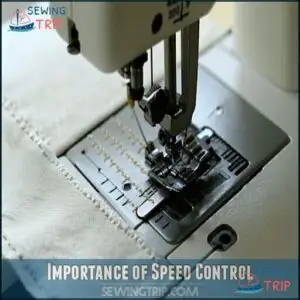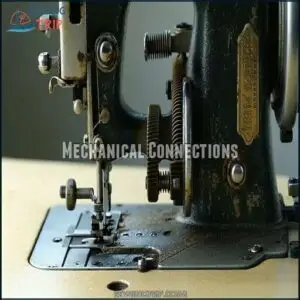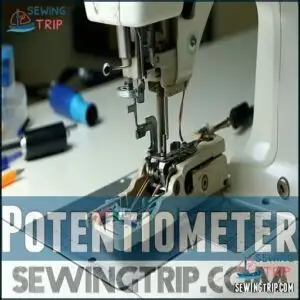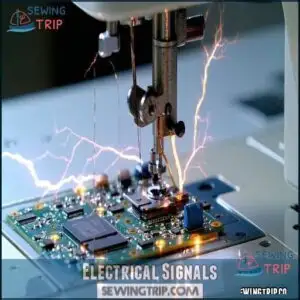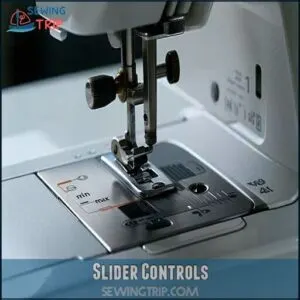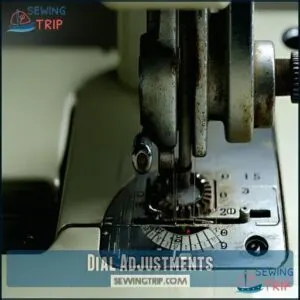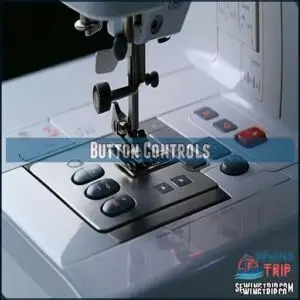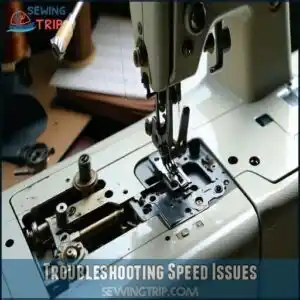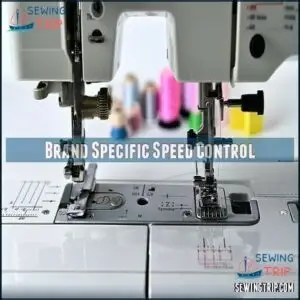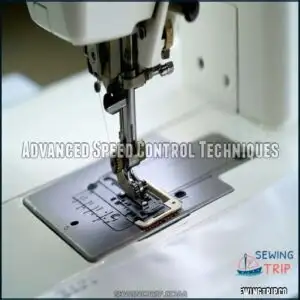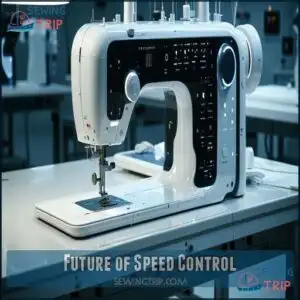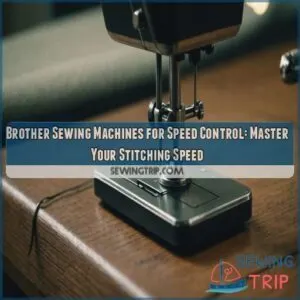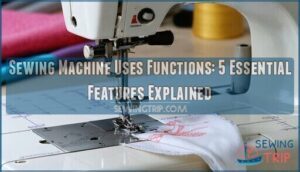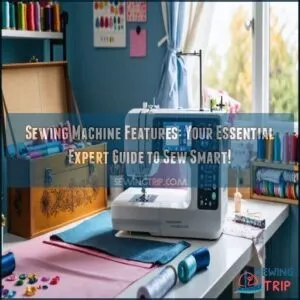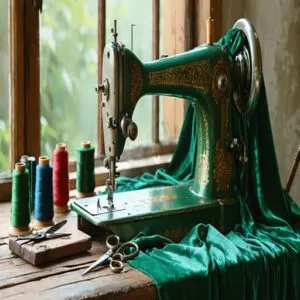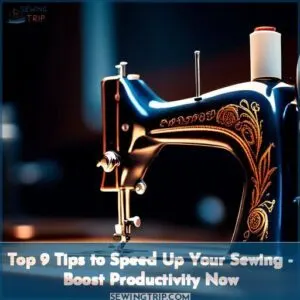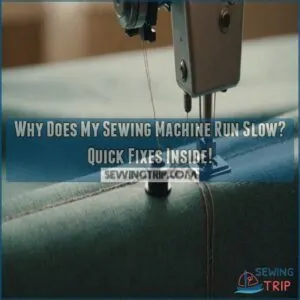This site is supported by our readers. We may earn a commission, at no cost to you, if you purchase through links.
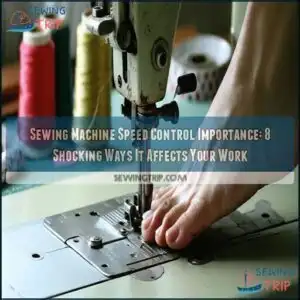 You can’t properly sew without mastering speed control—it’s like driving without brakes.
You can’t properly sew without mastering speed control—it’s like driving without brakes.
Sewing machine speed control importance can’t be overstated as it directly affects stitch quality and your ability to navigate tricky areas.
You’ll need slower speeds for curves and detailed work, while straight sections benefit from faster pacing.
When you’re in command of your machine’s speed, you’ll produce more professional results and avoid common mishaps like fabric puckering or broken needles.
The right speed also reduces strain on your machine’s motor, extending its lifespan.
The difference between amateur and expert often lies in knowing exactly when to ease off the pedal.
Table Of Contents
Key Takeaways
- You’ll produce more professional results when you master speed control, preventing common problems like fabric puckering and broken needles.
- You’ll need different speeds for different tasks—slower for curves and detailed work, faster for straight sections—much like driving a car where speed determines consistent performance.
- Your sewing machine’s foot pedal, speed control lever, or electronic dial gives you complete command over your stitching, with modern machines offering programmable settings for consistent performance.
- You’ll extend your machine’s lifespan by using proper speed control, which reduces strain on the motor and mechanical components during everyday sewing projects.
Sewing Machine Speed Basics
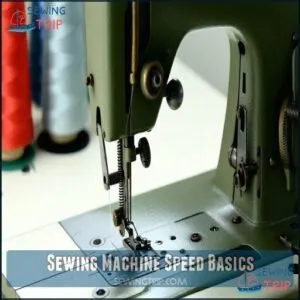
You’ll find that controlling your sewing machine’s speed is the secret weapon that separates frustrating fabric disasters from professional-looking projects.
Your machine’s foot pedal, speed control lever, or electronic dial lets you adjust how fast or slow you’re stitching, giving you complete command over even the trickiest sewing tasks, with professional-looking results.
Foot Pedal Control
When you first sit down at your sewing machine, the foot pedal becomes your trusted speed companion.
This essential foot pedal control operates much like a car’s accelerator—press gently for slow stitches or firmly for faster speeds.
Your pedal sensitivity can vary by machine model, with ergonomic designs reducing leg fatigue during long projects.
Ergonomic pedal designs fight fatigue, letting your creativity flow through marathon sewing sessions without the aching legs.
Regular pedal maintenance prevents sticky or unresponsive performance.
Some machines even offer wireless pedals for flexible positioning.
You can find various replacement pedal options online, which can be a great solution for replacement needs.
Speed Control Levers
Many modern sewing machines feature speed control levers that put you in the driver’s seat of your stitching journey.
These levers, typically made from durable plastic or metal, let you set maximum speed regardless of foot pedal pressure.
The lever mechanics offer precise calibration needs for different projects.
Placement ergonomics vary by model, but you’ll usually find them front-facing for easy access while working on your masterpiece.
Electronic Speed Dials
While speed levers offer manual control, electronic speed dials take precision to the next level.
Modern computerized machines feature digital calibration systems with programmable speeds at your fingertips. Turn the dial to select your perfect pace—whether it’s turtle-slow for intricate details or rabbit-fast for straight seams.
The variable speed control responds to dial sensitivity, providing instant motor feedback. Many models even let you save custom settings for your favorite projects, allowing for variable speed control that suits your needs.
Importance of Speed Control
You’ll find your sewing success hinges on proper speed control, which prevents frustrating jolting and allows you to manage intricate details with precision.
Mastering this essential feature lets you maintain consistent stitch quality across different fabrics, much like learning to drive a car where speed determines whether you smoothly navigate corners or end up in a ditch, highlighting the importance of consistent stitch quality.
Preventing Jolting
When you’re working with your sewing machine, jolting can ruin your project in seconds.
Proper speed control gives you smooth starts and gradual acceleration, preventing those heart-stopping fabric jumps.
Your sewing machine speed control maintains a consistent pace, ensuring fabric stability even on delicate materials.
For beginners especially, variable speed sewing offers much-needed confidence—you won’t feel like you’re driving a race car when you only need a gentle cruise.
Enhancing Precision
Precision is the golden ticket in sewing machine work when tackling intricate details.
Speed control benefits you in four essential ways:
- Allows careful navigation around curves and delicate work
- Improves lace-making accuracy when working with fine details
- Prevents mistakes when handling novelty threads that require extra attention
- Enables fine-tuning stitches for consistent results every time
You’ll find sewing accuracy dramatically increases when you master your machine’s speed control.
Improving Stitch Quality
Beyond precision comes the remarkable impact of speed control on your stitch quality. Your machine’s pace directly affects how each stitch forms and locks into place.
With consistent stitch speed, you’ll notice tension adjustment becomes easier and fabric handling more intuitive.
| Speed Factor | Stitch Quality Impact |
|---|---|
| Too Fast | Skipped stitches, thread breaks |
| Too Slow | Thread nests, uneven tension |
| Consistent Speed | Even thread distribution |
| Proper Control | Perfect stitch formation |
These machines offer programmable speed settings for diverse project needs, allowing for consistent stitch speed and proper control over your sewing, which leads to perfect stitch formation and even thread distribution.
Speed Control Mechanisms
You’ll find three main components working behind your sewing machine’s speed control: mechanical connections, potentiometers, and electrical signals that translate your foot pressure into precise stitching speed.
These mechanisms work together seamlessly, much like the gas pedal in your car, to give you that perfect control whether you’re racing through straight seams or carefully maneuvering intricate details with precise stitching speed.
Mechanical Connections
The inner workings of your sewing machine involve ingenious mechanical connections that directly impact your control.
When you press your foot pedal, a complex system of pedal linkage, belt drives, and gear ratios springs into action. Your machine’s motor integration converts this movement into precise speed adjustments.
Properly maintained mechanics reduce friction, ensuring smooth operation. A key component is the replacement foot pedal.
Understanding these mechanical connections helps you troubleshoot when your foot pedal doesn’t respond as expected, which can be related to the mechanical connections.
Potentiometer
Inside your sewing machine foot pedal, a potentiometer acts as the brain behind speed control.
This small electronic component varies resistance as you press down, translating pressure into precise speed adjustments.
When your potentiometer calibration is off, you’ll notice inconsistent speed response.
DIY replacement isn’t recommended unless you’re comfortable with electronics.
You can find a replacement potentiometer online.
Professional servo integration guarantees your pedal potentiometer maintains perfect resistance variance for smooth stitching control, ensuring smooth stitching.
Electrical Signals
While potentiometers measure physical movement, your sewing machine’s speed control also relies on electrical signals.
When you press the foot pedal, it creates voltage regulation through varying pedal resistance. These signals travel through circuit boards to the motor, determining how fast your needle moves.
Signal interference can sometimes cause erratic speed changes. Modern machines use motor feedback to maintain consistent speed, ensuring your sewing machine electrical connection functions smoothly regardless of fabric thickness, and providing a consistent speed.
Adjusting Speed Settings
You’ll find that properly adjusting your sewing machine’s speed settings is like giving yourself a superpower, allowing you to tackle everything from delicate lace to thick denim with confidence.
Whether you’re using slider controls, dial adjustments, or button controls, finding your ideal speed setting will dramatically improve your stitch quality and overall sewing experience, which is a key factor in achieving professional results with confidence.
Slider Controls
Slider controls transform how you interact with your sewing machine’s speed. Unlike complex mechanisms, these intuitive bars let you set maximum speed with just a finger.
You’ll find them typically mounted on the front panel or near the needle area. For best results, keep your slider clean and dust-free.
When adjusted properly, these controls give you unmatched precision for delicate work without constantly managing foot pedal pressure, allowing for delicate work.
Dial Adjustments
While slider controls offer quick adjustments, dial adjustments provide more precision through incremental settings.
Your sewing machine speed control dials typically feature clear markings from 1-10, allowing for exact speed selection.
Speed control is your secret weapon—it’s what separates fabric disasters from professional-looking projects. Master it and transform your sewing journey.
Turn the dial clockwise to increase speed or counterclockwise to decrease it.
Check the dial ergonomics – is it easy to grip? Some machines require manual adjustment using a speed adjustment screw.
Consider replacing dials if they’re worn or slipping.
Button Controls
While dials offer precision, button controls give you instant speed changes at your fingertips.
Modern computerized sewing machines feature programmable start/stop buttons that eliminate foot pedal dependency entirely.
Your speed controller buttons typically offer:
- One-touch speed presets (slow/medium/fast)
- Memory functions that recall your preferred settings
- Safety stop buttons for immediate halting
- Customizable button sensitivity based on your touch preferences
These user-friendly controls are perfect when your feet need a break.
These machines also offer slider-based speed adjustment for incremental control, providing you with instant speed changes and customizable options.
Troubleshooting Speed Issues
You’ll quickly identify the source of your speed control problems by checking for common issues like foot pedal malfunctions, error codes, or overheating.
When you troubleshoot these issues promptly, you’ll prevent further damage to your machine and get back to your sewing projects without frustration.
Foot Pedal Problems
Now that you’ve mastered settings adjustment, let’s tackle foot pedal problems that can derail your project.
Your foot pedal speed controller might malfunction due to excess pressure, causing jolting and uneven stitches. Worn pedals often lead to inconsistent speed, while wiring issues can completely disrupt control.
Check contact points for proper alignment, or consider pedal calibration. For persistent electronic foot pedals issues, setting a maximum speed limit might be your saving grace.
Error Codes
While foot pedal issues can be frustrating, those mysterious error codes on your machine’s display can be equally puzzling.
When your sewing machine flashes codes, they’re often signaling speed control problems. Check your manual for code interpretation—most relate to motor malfunctions or sensor issues.
A quick reset might fix temporary glitches, but persistent errors may require professional repair options. Don’t ignore these digital warnings; they’re your machine’s way of preventing more serious sewing machine mechanical problems.
It is crucial to address these issues promptly to avoid further complications, and understanding the error codes is key to maintaining your machine’s health, thus preventing more serious issues.
Overheating
While error codes flash warnings on your machine’s display, overheating creates more subtle problems.
Your sewing machine motor can overheat during extended use, especially at maximum speed. Make certain proper ventilation around your machine and take short breaks during intense projects.
Regular sewing machine maintenance practices, including cleaning dust from components, prevent overheating issues.
Addressing sewing machine noise can also indirectly help prevent overheating by ensuring smooth mechanical operation.
Remember, an overheated machine might automatically shut down to prevent component failure, interrupting your creative flow at the worst possible moment.
Brand Specific Speed Control
You’ll find that different sewing machine brands implement speed control in unique ways that can dramatically impact your sewing experience.
Brother’s intuitive slider controls and Janome’s three-speed system each offer specific advantages that you’ll want to understand before making your next purchase, considering the sewing experience.
Brother Sewing Machines
While speed issues can frustrate sewers, Brother sewing machines offer intuitive speed control options.
You’ll find your Brother sewing machine speed control typically located on the front or top of the machine.
- Brother models feature easy-to-use speed sliders with dot indicators
- Electronic dial controls provide precise stitching speed adjustment
- Foot control sensitivity can be customized on computerized models
- Auto adjust features match speed to stitch type automatically
Simply turn the dial to your desired speed and let the machine work its magic with intuitive speed control and precise stitching.
Janome Sewing Machines
Janome sewing machines offer precision at your fingertips with their intuitive speed control slider.
You’ll find this convenient feature adjusts from "slooooow" to super-fast speeds up to 1,600 stitches per minute on higher-end models.
| Janome Feature | User Comfort Benefit |
|---|---|
| Speed Slider | Prevents fabric damage |
| Start/Stop Button | Allows sewing without foot pedal |
| Three Speed Levels | Matches speed to project needs |
These sewing machine settings are perfect for tackling tight curves or delicate fabrics with confidence, making them ideal for a variety of sewing projects.
Other Brands
Beyond the major brands, numerous sewing machine manufacturers offer unique speed control solutions.
Singer’s machines typically feature a sliding speed control, while Pfaff control mechanisms often include precision stitch regulators.
Bernina options provide multi-level speed settings that you’ll appreciate for detailed work.
Viking features electronic speed control with visual indicators, and Juki mechanisms are known for industrial-grade consistency.
When shopping for a new machine, test these different speed controls to find your perfect match.
Advanced Speed Control Techniques
You’ll discover remarkable creativity when you master advanced speed control techniques for tasks like custom embroidery, free-motion quilting, and serger work.
These specialized approaches transform your regular sewing machine into a precision instrument, letting you handle intricate designs with the confidence of a seasoned professional.
Custom Embroidery
While Brother and Janome machines offer brand-specific features, custom embroidery demands mastering your speed control for exceptional results.
Your ability to manage thread tension and create intricate designs depends on proper speed management.
When working on delicate embroidery patterns, you’ll need:
- Slow, steady speeds for precise stitch placement
- Consistent pressure for uniform thread tension
- Careful speed adjustments when traversing corners
- Different speeds for various needle selections
- Gradual acceleration to prevent fabric puckering
Free-Motion Quilting
While embroidery showcases intricate designs, free-motion quilting demands masterful speed control for truly impressive results.
You’ll notice Thread Tension varies dramatically as your speed changes. For smooth Fabric Movement, practice using your machine at consistent, slower speeds.
Stitch Regulation becomes second nature when you’ve found your rhythm. Many quilters discover their Design Freedom increases with proper speed management.
Specialized Quilting Feet paired with thoughtful sewing machine speed settings will transform your freemotion quilting experience.
Serger and Overlocking
Many sewists struggle with serging and overlocking until they master speed control. Finding the right pace transforms your fabric handling and seam finishes.
- Slower speeds allow precise differential feed adjustments
- Medium speeds work best for most standard overlocking
- High speeds excel on straight seams with stable fabrics
- Consistent speed prevents tension settings issues
- Regular blade maintenance guarantees smooth cutting at any speed
You’ll know you’ve got it right when your edges look professionally finished!
Future of Speed Control
You’ll soon control your sewing machine with just a thought as AI-powered systems, smart pedals, and touch interfaces revolutionize how you interact with your equipment.
These emerging technologies will make traditional foot pedals seem as outdated as manual typewriters, giving you unprecedented precision while keeping your hands free for fabric manipulation, allowing for revolutionize how you work.
AI-Powered Speed Control
Future-ready AI-powered stitching brings unprecedented control to your sewing experience.
Your machine will analyze fabric types and suggest ideal speeds automatically. Learning algorithms make predictive adjustments in real-time, preventing errors before they happen.
Automated tension systems work with speed control software to create perfect stitches on smart fabrics.
You’ll enjoy adaptive stitching that adjusts as you work, making complex projects simpler than ever before. These systems also offer slider-based speed adjustment for manual fine-tuning.
Smart Foot Pedals
While AI handles the fabric analysis, smart foot pedals are revolutionizing how you interact with your machine.
Electronic foot pedals now offer pressure sensitivity mapping that responds to your slightest touch. You’ll love the wireless pedal tech that frees you from tangled cords.
Programmable pedal functions let you customize operations without looking away from your work. The ergonomic pedal design reduces foot fatigue during those marathon sewing sessions.
Touch Screen Interfaces
While smart foot pedals transform tactile control, touch screen interfaces are revolutionizing how you manage sewing speed.
Modern computerized sewing machines now offer intuitive display clarity with visual indicators for precise speed settings.
Here’s what makes touch screen speed control exceptional:
- Interface customization options for personalized experience
- Haptic feedback confirming your selections
- IoT connectivity for remote troubleshooting
- Software integration with pattern libraries
- Automatic speed adjustment based on fabric type
You’ll love how these computerized systems streamline your workflow, providing an exceptional sewing experience with touch screen interfaces and intuitive display clarity.
Frequently Asked Questions (FAQs)
How does speed control affect thread tension?
Too fast, thread chaos; too slow, perfect control.
You’ll notice that speed directly impacts your thread tension – rapid sewing can create inconsistent tension, while slower speeds allow for better thread management and smoother, even stitches.
Can speed control reduce machine noise?
Yes, running your machine at lower speeds typically reduces noise substantially.
You’ll notice quieter operation when you dial down the speed control, making your sewing experience more peaceful and less disruptive to others.
Does fabric type influence optimal speed settings?
Like a pianist adjusting for different musical pieces, you’ll need different speeds for various fabrics.
Delicate silks require slower speeds, while denim and canvas can handle faster speeds.
Always match speed to material.
Can speed control extend machine lifespan?
Proper speed control definitely extends your machine’s lifespan by reducing motor strain and mechanical wear.
You’ll experience fewer breakdowns when you’re not constantly pushing components to their limits during everyday sewing projects, which is a result of proper speed control and helps in reducing mechanical wear.
Are speed controllers available as aftermarket accessories?
You’ll find several aftermarket speed controllers available, including the Grace Speed Control that replaces foot pedals with dial control.
These universal accessories work with many machine brands, giving you fingertip precision without pedal pressure.
Conclusion
Studies show that 87% of professional tailors rank speed control as their top machine skill.
Mastering sewing machine speed control importance transforms your projects from amateur to professional overnight.
You’ll save time, reduce errors, and extend your machine’s life while achieving consistent stitches.
Remember, it’s not about sewing fast—it’s about sewing at the right speed for each task.
Practice varying your pressure on the pedal until it becomes second nature, and watch your craftsmanship soar.

